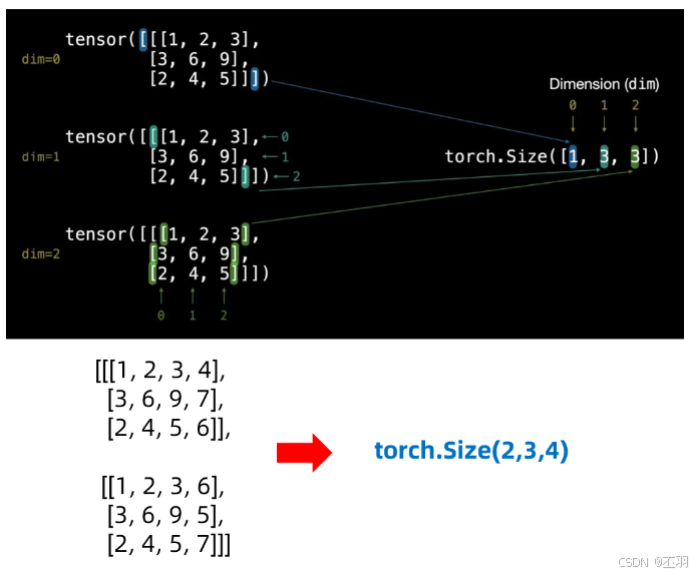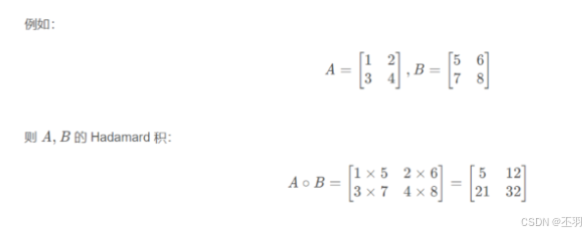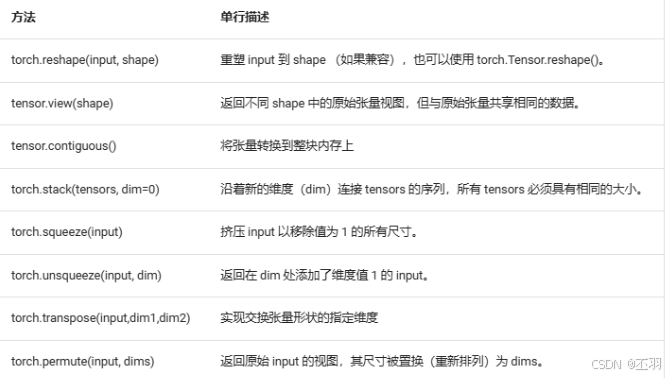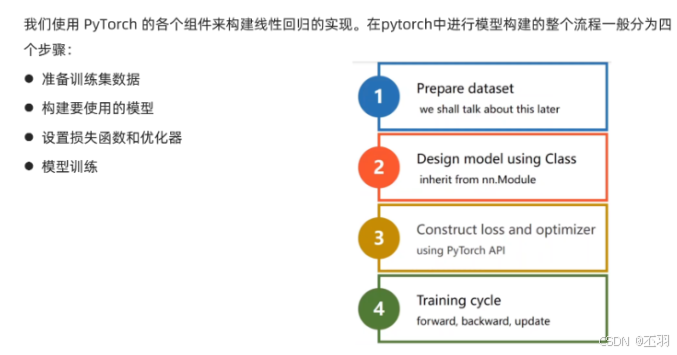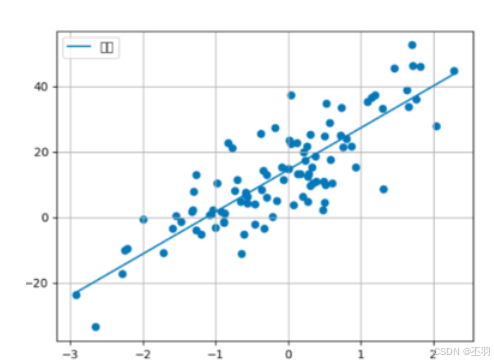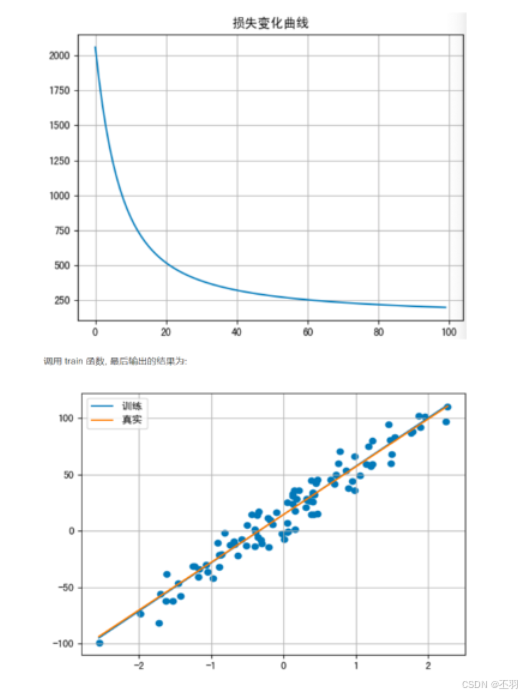Pytorch的基本语法
张量简介
张量 Tensor 是机器学习的基本构建模块,是以数字方式表示数据的形式.
在张量语言(用于描述张量的语言)中,张量将具有三个维度,一个维度表示 colour_channels 、 height 和 width 。
张量的基本使用
基本类型
# 0维张量:标量(scalar)
scalar = torch.tensor(7)
scalar.ndim
>>> 0
# 1维张量:向量(vector)
vector = torch.tensor([7, 7])
vector.ndim
>>> 1
# 2维张量:矩阵(matrix)
MATRIX = torch.tensor([[7, 8],
[9, 10]])
MATRIX.ndim
>>> 2
# 多维张量
TENSOR = torch.tensor([[[1, 2, 3],
[3, 6, 9],
[2, 4, 5]]])
TENSOR.ndim
>>> 3
张量的创建
张量的基本创建方式
torch.tensor()根据指定数据创建张量
import torch
import numpy as np
# 创建张量标量
data = torch.tensor(10)
print(data)
# 2. numpy 数组, 由于 data 为 float64, 下面代码也使用该类型
data = np.random.randn(2, 3)
data = torch.tensor(data)
print(data)
>>> tensor([[ 0.1345, 0.1149, 0.2435],
[ 0.8026, -0.6744, -1.0918]], dtype=torch.float64)
# 3. 列表, 下面代码使用默认元素类型 float32
data = [[10., 20., 30.], [40., 50., 60.]]
data = torch.tensor(data)
print(data)
>>> tensor([[10., 20., 30.],
[40., 50., 60.]])
torch.Tensor()根据指定形状创建张量,也可以用来创建指定数据的张量
# 1. 创建2行3列的张量, 默认 dtype 为 float32
data = torch.Tensor(2, 3)
print(data)
>>> tensor([[0.0000e+00, 3.6893e+19, 2.2018e+05],
[4.6577e-10, 2.4158e-12, 1.1625e+33]])
# 2. 注意: 如果传递列表, 则创建包含指定元素的张量
data = torch.Tensor([10])
print(data)
>>> tensor([10.])
data = torch.Tensor([10, 20])
print(data)
>>> tensor([10., 20.])
torch.FloatTensor()、torch.DoubleTensor() 创建指定类型的张量
# 1. 创建2行3列, dtype 为 int32 的张量
data = torch.IntTensor(2, 3)
print(data)
>>> tensor([[ 0, 1610612736, 1213662609],
[ 805308409, 156041223, 1]], dtype=torch.int32)
# 2. 注意: 如果传递的元素类型不正确, 则会进行类型转换
data = torch.IntTensor([2.5, 3.3])
print(data)
>>> tensor([2, 3], dtype=torch.int32)
# 3. 其他的类型
data = torch.ShortTensor() # int16
data = torch.LongTensor() # int64
data = torch.FloatTensor() # float32
data = torch.DoubleTensor() # float64
创建线性张量和随机张量
torch.arange() torch.linspace()创建线性张量
# 1. 在指定区间按照步长生成元素 [start, end, step) 左闭右开
data = torch.arange(0, 10, 2)
print(data)
>>> tensor([0, 2, 4, 6, 8])
# 2. 在指定区间按照元素个数生成 [start, end, steps] 左闭右闭
data = torch.linspace(0, 11, 10)
print(data)
>>> tensor([0.0000, 1.2222, 2.4444, 3.6667, 4.8889, 6.1111, 7.3333, 8.5556, 9.7778,
随机种子操作
- torch.random.initial_seed()查看随机种子
- torch.random.manual_seed() 设置随机数种子
- torch.randn() 创建随机张量
# 1. 创建随机张量
data = torch.randn(2, 3) # 创建2行3列张量
print(data)
>>> tensor([[-0.5209, -0.2439, -1.1780],
[ 0.8133, 1.1442, 0.6790]])
# 2.查看随机数种子
print('随机数种子:', torch.random.initial_seed())
>>> 随机数种子: 4508475192273306739
# 3.设置随机数种子
torch.random.manual_seed(100)
data = torch.randn(2, 3)
print(data)
print('随机数种子:', torch.random.initial_seed())
>>> tensor([[ 0.3607, -0.2859, -0.3938],
[ 0.2429, -1.3833, -2.3134]])
随机数种子: 100
创建0-1张量
- torch.ones 和 torch.ones_like 创建全1张量
- torch.zeros 和 torch.zeros_like 创建全0张量
- torch.full 和 torch.full_like 创建全为指定值张量
torch.ones()、torch.ones_like() 创建全1张量
# 1. 创建指定形状全0张量
data = torch.zeros(2, 3)
print(data)
>>> tensor([[0., 0., 0.],
[0., 0., 0.]])
# 2. 根据张量形状创建全0张量
data = torch.zeros_like(data)
print(data)
>>> tensor([[0., 0., 0.],
[0., 0., 0.]])
torch.zeros()、torch.zeros_like() 创建全0张量
# 1. 创建指定形状全1张量
data = torch.ones(2, 3)
print(data)
>>> tensor([[1., 1., 1.],
[1., 1., 1.]])
# 2. 根据张量形状创建全1张量
data = torch.ones_like(data)
print(data)
>>> tensor([[1., 1., 1.],
[1., 1., 1.]])
torch.full()、torch.full_like() 创建全为指定值张量
# 1. 创建指定形状指定值的张量
data = torch.full([2, 3], 10)
print(data)
>>> tensor([[10, 10, 10],
[10, 10, 10]])
# 2. 根据张量形状创建指定值的张量
data = torch.full_like(data, 20)
print(data)
>>> tensor([[20, 20, 20],
[20, 20, 20]])
张量元素类型转换
- data.type(torch.DoubleTensor)
- data.double()
data.type(torch.Double Tensor)
data = torch.full([2, 3], 10)
print(data.dtype)
>>> torch.int64
# 将 data 元素类型转换为 float64 类型
data = data.type(torch.DoubleTensor)
print(data.dtype)
>>> torch.float64
# 转换为其他类型
# data = data.type(torch.ShortTensor) # int16
# data = data.type(torch.IntTensor) # int32
# data = data.type(torch.LongTensor) # int64
# data = data.type(torch.FloatTensor) # float32
data.double()
data = torch.full([2, 3], 10)
print(data.dtype)
>>> torch.int64
# 将 data 元素类型转换为 float64 类型
data = data.double()
print(data.dtype)
>>> torch.float64
# 转换为其他类型
# data = data.short()
# data = data.int()
# data = data.long()
# data = data.float()
张量的类型转换
张量转换为Numpy数组
- 使用 Tensor.numpy 函数可以将张量转换为 ndarray 数组,但是共享内存,可以使用 copy 函数避免共享。
# 1. 将张量转换为 numpy 数组
data_tensor = torch.tensor([2, 3, 4])
# 使用张量对象中的 numpy 函数进行转换
data_numpy = data_tensor.numpy()
print(type(data_tensor))
>>> <class 'torch.Tensor'>
print(type(data_numpy))
>>> <class 'numpy.ndarray'>
# 注意: data_tensor 和 data_numpy 共享内存
# 修改其中的一个,另外一个也会发生改变
# data_tensor[0] = 100
data_numpy[0] = 100
print(data_tensor)
>>> tensor([100, 3, 4])
print(data_numpy)
>>> [100 3 4]
# 2. 对象拷贝避免共享内存
data_tensor = torch.tensor([2, 3, 4])
# 使用张量对象中的 numpy 函数进行转换,通过copy方法拷贝对象
data_numpy = data_tensor.numpy().copy()
print(type(data_tensor))
>>> <class 'torch.Tensor'>
print(type(data_numpy))
>>> <class 'numpy.ndarray'>
# 注意: data_tensor 和 data_numpy 此时不共享内存
# 修改其中的一个,另外一个不会发生改变
# data_tensor[0] = 100
data_numpy[0] = 100
print(data_tensor)
>>> tensor([2, 3, 4])
print(data_numpy)
>>> [100 3 4]
Numpy转换为tensor
- 使用 from_numpy 可以将 ndarray 数组转换为 Tensor,默认共享内存,使用 copy 函数避免共享。
data_numpy = np.array([2, 3, 4])
# 将 numpy 数组转换为张量类型
# 1. from_numpy
# 2. torch.tensor(ndarray)
data_tensor = torch.from_numpy(data_numpy)
# nunpy 和 tensor 共享内存
# data_numpy[0] = 100
data_tensor[0] = 100
print(data_tensor)
>>> tensor([100, 3, 4], dtype=torch.int32)
print(data_numpy)
>>> [100 3 4]
- 使用 torch.tensor 可以将 ndarray 数组转换为 Tensor,默认不共享内存。
data_numpy = np.array([2, 3, 4])
data_tensor = torch.tensor(data_numpy)
# nunpy 和 tensor 不共享内存
# data_numpy[0] = 100
data_tensor[0] = 100
print(data_tensor)
>>> tensor([100, 3, 4], dtype=torch.int32)
print(data_numpy)
>>> [2 3 4]
标量张量和数字转换
- 对于只有一个元素的张量,使用item()函数将该值从张量中提取出来
# 当张量只包含一个元素时, 可以通过 item() 函数提取出该值
data = torch.tensor([30,])
print(data.item())
>>> 30
data = torch.tensor(30)
print(data.item())
>>> 30x
张量的数值计算
张量的基本运算
- 加减乘除取负号:
- add、sub、mul、div、neg
- add_、sub_、mul_、div_、neg_(其中带下划线的版本会修改原数据)
data = torch.randint(0, 10, [2, 3])
print(data)
>>> tensor([[3, 7, 4],
[0, 0, 6]])
# 1. 不修改原数据
new_data = data.add(10) # 等价 new_data = data + 10
print(new_data)
>>> tensor([[13, 17, 14],
[10, 10, 16]])
# 2. 直接修改原数据 注意: 带下划线的函数为修改原数据本身
data.add_(10) # 等价 data += 10
print(data)
>>> tensor([[13, 17, 14],
[10, 10, 16]])
# 3. 其他函数
print(data.sub(100))
>>> tensor([[-87, -83, -86],
[-90, -90, -84]])
print(data.mul(100))
>>> tensor([[1300, 1700, 1400],
[1000, 1000, 1600]])
print(data.div(100))
>>> tensor([[0.1300, 0.1700, 0.1400],
[0.1000, 0.1000, 0.1600]])
print(data.neg())
>>> tensor([[-13, -17, -14],
[-10, -10, -16]])
张量点乘运算
- 点乘指(Hadamard)的是两个同维矩阵对应位置的元素相乘,使用mul 和运算符 * 实现。
data1 = torch.tensor([[1, 2], [3, 4]])
data2 = torch.tensor([[5, 6], [7, 8]])
# 第一种方式
data = torch.mul(data1, data2)
print(data)
>>> tensor([[ 5, 12],
[21, 32]])
# 第二种方式
data = data1 * data2
print(data)
>>> tensor([[ 5, 12],
[21, 32]])
张量矩阵乘法运算
- 矩阵乘法运算要求第一个矩阵 shape: (n, m),第二个矩阵 shape: (m, p), 两个矩阵点积运算 shape 为: (n, p)。
- 运算符 @ 用于进行两个矩阵的乘积运算
- torch.matmul 对进行乘积运算的两矩阵形状没有限定.对数输入的 shape 不同的张量, 对应的最后几个维度必须符合矩阵运算规则
# 点积运算
data1 = torch.tensor([[1, 2], [3, 4], [5, 6]])
data2 = torch.tensor([[5, 6], [7, 8]])
# 方式一:
data3 = data1 @ data2
print("data3-->", data3)
>>> data3--> tensor([[19, 22],
[43, 50],
[67, 78]])
# 方式二:
data4 = torch.matmul(data1, data2)
print("data4-->", data4)
>>> data4--> tensor([[19, 22],
[43, 50],
[67, 78]])
张量的运算函数
PyTorch 为每个张量封装很多实用的计算函数:
- 均值
- 平方根
- 求和
- 指数计算
- 对数计算等等
import torch
data = torch.randint(0, 10, [2, 3], dtype=torch.float64)
print(data)
>>> tensor([[4., 0., 7.],
[6., 3., 5.]], dtype=torch.float64)
# 1. 计算均值
# 注意: tensor 必须为 Float 或者 Double 类型
print(data.mean())
>>> tensor(4.1667, dtype=torch.float64)
print(data.mean(dim=0)) # 按列计算均值
>>> tensor([5.0000, 1.5000, 6.0000], dtype=torch.float64)
print(data.mean(dim=1)) # 按行计算均值
>>> tensor([3.6667, 4.6667], dtype=torch.float64)
# 2. 计算总和
print(data.sum())
>>> tensor(25., dtype=torch.float64)
print(data.sum(dim=0))
>>> tensor([10., 3., 12.], dtype=torch.float64)
print(data.sum(dim=1))
>>> tensor([11., 14.], dtype=torch.float64)
# 3. 计算平方
print(torch.pow(data,2))
>>> tensor([[16., 0., 49.],
[36., 9., 25.]], dtype=torch.float64)
# 4. 计算平方根
print(data.sqrt())
>>> tensor([[2.0000, 0.0000, 2.6458],
[2.4495, 1.7321, 2.2361]], dtype=torch.float64)
# 5. 指数计算, e^n 次方
print(data.exp())
>>> tensor([[5.4598e+01, 1.0000e+00, 1.0966e+03],
[4.0343e+02, 2.0086e+01, 1.4841e+02]], dtype=torch.float64)
# 6. 对数计算
print(data.log()) # 以 e 为底
>>> tensor([[1.3863, -inf, 1.9459],
[1.7918, 1.0986, 1.6094]], dtype=torch.float64)
print(data.log2())
>>> tensor([[2.0000, -inf, 2.8074],
[2.5850, 1.5850, 2.3219]], dtype=torch.float64)
print(data.log10())
>>> tensor([[0.6021, -inf, 0.8451],
[0.7782, 0.4771, 0.6990]], dtype=torch.float64)
张量的索引操作
- 在操作张量时,经常要去获取某些元素进行处理或者修改操作,在这里需要了解torch中的索引操作。
准备数据
import torch
# 随机生成数据
data = torch.randint(0, 10, [4, 5])
print(data)
>>> tensor([[0, 7, 6, 5, 9],
[6, 8, 3, 1, 0],
[6, 3, 8, 7, 3],
[4, 9, 5, 3, 1]])
简单行列索引的使用
print(data[0])
>>> tensor([0, 7, 6, 5, 9])
print(data[:, 0])
>>> tensor([0, 6, 6, 4])
列表索引的使用
# 返回 (0, 2)、(1, 3) 两个位置的元素
print(data[[0, 1], [2, 3]])
>>> tensor([7, 3])
# 返回 0、1 行的 1、2 列共4个元素
print(data[[[0], [1]], [1, 2]])
>>> tensor([[7, 6],
[8, 3]])
范围索引的使用
# 前3行的前2列数据
print(data[:3, :2])
>>> tensor([[0, 7],
[6, 8],
[6, 3]])
# 第2行到最后的前2列数据
print(data[2:, :2])
>>> tensor([[6, 3],
[4, 9]])
# 第0行、第2行的第0、1两列数据
print(data[0:3:2, :2])
>>>tensor([[0, 7],
[6, 3]])
布尔索引的使用
# 第三列大于5的行数据
print(data[data[:, 2] > 5])
>>> tensor([[0, 7, 6, 5, 9],
[6, 3, 8, 7, 3]])
# 第二行大于5的列数据
print(data[:, data[1] > 5])
>>> tensor([[0, 7],
[6, 8],
[6, 3],
[4, 9]])
多维索引的使用
data = torch.randint(0, 10, [3, 4, 5])
print(data)
>>> tensor([[[2, 4, 1, 2, 3],
[5, 5, 1, 5, 0],
[1, 4, 5, 3, 8],
[7, 1, 1, 9, 9]],
[[9, 7, 5, 3, 1],
[8, 8, 6, 0, 1],
[6, 9, 0, 2, 1],
[9, 7, 0, 4, 0]],
[[0, 7, 3, 5, 6],
[2, 4, 6, 4, 3],
[2, 0, 3, 7, 9],
[9, 6, 4, 4, 4]]])
# 获取0轴上的第一个数据
print(data[0, :, :])
>>> tensor([[2, 4, 1, 2, 3],
[5, 5, 1, 5, 0],
[1, 4, 5, 3, 8],
[7, 1, 1, 9, 9]])
# 获取1轴上的第一个数据
print(data[:, 0, :])
>>> tensor([[2, 4, 1, 2, 3],
[9, 7, 5, 3, 1],
[0, 7, 3, 5, 6]])
# 获取2轴上的第一个数据
print(data[:, :, 0])
>>> tensor([[2, 5, 1, 7],
[9, 8, 6, 9],
[0, 2, 2, 9]])
张量的形状操作
有重塑 堆叠 挤压 和 解压
深度学习模型(神经网络)都是以某种方式操纵张量。由于矩阵乘法的规则,如果形状不匹配,就会遇到错误。这些方法可帮助您确保张量的正确元素与其他张量的正确元素混合。
举例说明:
import torch
x = torch.arange(1., 8.)
print(x)
>>> tensor([1., 2., 3., 4., 5., 6., 7.])
print(x.shape)
>>> torch.Size([7])
reshape
reshape 函数可以在保证张量数据不变的前提下改变数据的维度,将其转换成指定的形状。
使用 torch.reshape() 增加一个维度。
# 增加一个维度
x_reshaped = x.reshape(1, 7)
print(x_reshaped)
>>> tensor([[1., 2., 3., 4., 5., 6., 7.]])
print(x_reshaped.shape)
>>> torch.Size([1, 7])
使用 torch.reshape() 改变张量的形状。
import torch
data = torch.tensor([[10, 20, 30], [40, 50, 60]])
# 1. 使用 shape 属性或者 size 方法都可以获得张量的形状
print(data.shape, data.shape[0], data.shape[1])
>>> torch.Size([2, 3]) 2 3
print(data.size(), data.size(0), data.size(1))
>>> torch.Size([2, 3]) 2 3
# 2. 使用 reshape 函数修改张量形状
new_data = data.reshape(1, 6)
print(new_data.shape)
>>> torch.Size([1, 6])
View / Contiguous
- view 函数也可以用于修改张量的形状,只能用于存储在整块内存中的张量。
- 在 PyTorch 中,有些张量是由不同的数据块组成的,它们并没有存储在整块的内存中,view 函数无法对这样的张量进行变形处理。例如: 一个张量经过了 transpose 或者 permute 函数的处理之后,就无法使用 view 函数进行形状操作。
- 此时需要先使用 contiguous 函数转换为整块内存的张量,再使用 view 函数。
# 1 一个张量经过了 transpose 或者 permute 函数的处理之后,就无法使用 view 函数进行形状操作
# 若要使用view函数, 需要使用contiguous() 变成连续以后再使用view函数
# 2 判断张量是否使用整块内存
data = torch.tensor( [[10, 20, 30],[40, 50, 60]])
print('data--->', data, data.shape)
>>> data---> tensor([[10, 20, 30],
[40, 50, 60]]) torch.Size([2, 3])
# 1 判断是否使用整块内存
print(data.is_contiguous())
>>> True
# 2 view
mydata2 = data.view(3, 2)
print('mydata2--->', mydata2, mydata2.shape)
>>> mydata2---> tensor([[10, 20],
[30, 40],
[50, 60]]) torch.Size([3, 2])
# 3 判断是否使用整块
print('mydata2.is_contiguous()--->', mydata2.is_contiguous())
>>> mydata2.is_contiguous()---> True
# 4 使用 transpose 函数修改形状
mydata3 = torch.transpose(data, 0, 1)
print('mydata3--->', mydata3, mydata3.shape)
>>> mydata3---> tensor([[10, 40],
[20, 50],
[30, 60]]) torch.Size([3, 2])
print('mydata3.is_contiguous()--->', mydata3.is_contiguous())
>>> mydata3.is_contiguous()---> False
# 5 需要先使用 contiguous 函数转换为整块内存的张量,再使用 view 函数
print (mydata3.contiguous().is_contiguous())
>>> True
mydata4 = mydata3.contiguous().view(2, 3)
print('mydata4--->', mydata4.shape, mydata4)
>>> mydata4---> torch.Size([2, 3]) tensor([[10, 40, 20],
[50, 30, 60]])
stack
如果想将新张量堆叠五次,使用 torch.stack() 来实现。
# Stack tensors on top of each other
x_stacked = torch.stack([x, x, x, x], dim=0) # 同pandas的axis,按行堆叠
>>>tensor([[5., 2., 3., 4., 5., 6., 7.],
[5., 2., 3., 4., 5., 6., 7.],
[5., 2., 3., 4., 5., 6., 7.],
[5., 2., 3., 4., 5., 6., 7.]])
Squeeze / Unsqueeze
squeeze 函数删除形状为 1 的维度(降维),unsqueeze 函数添加形状为1的维度(升维)。
mydata1 = torch.tensor([1, 2, 3, 4, 5])
print('mydata1--->', mydata1.shape, mydata1) # 一个普通的数组 1维数据
>>> mydata1---> torch.Size([5]) tensor([1, 2, 3, 4, 5])
mydata2 = mydata1.unsqueeze(dim=0)
print('在0维度上 拓展维度:', mydata2, mydata2.shape) #1*5
>>> 在0维度上 拓展维度: tensor([[1, 2, 3, 4, 5]]) torch.Size([1, 5])
mydata3 = mydata1.unsqueeze(dim=1)
print('在1维度上 拓展维度:', mydata3, mydata3.shape) #5*1
>>> 在1维度上 拓展维度: tensor([[1],
[2],
[3],
[4],
[5]]) torch.Size([5, 1])
mydata4 = mydata1.unsqueeze(dim=-1)
print('在-1维度上 拓展维度:', mydata4, mydata4.shape) #5*1
>>> 在-1维度上 拓展维度: tensor([[1],
[2],
[3],
[4],
[5]]) torch.Size([5, 1])
mydata5 = mydata4.squeeze()
print('压缩维度:', mydata5, mydata5.shape) #1*5
>>> 压缩维度: tensor([1, 2, 3, 4, 5]) torch.Size([5])
Transpose/ Permute
transpose 函数可以实现交换张量形状的指定维度, 例如: 一个张量的形状为 (2, 3, 4) 可以通过 transpose 函数把 3 和 4 进行交换, 将张量的形状变为 (2, 4, 3) 。 permute 函数可以一次交换更多的维度。
data = torch.tensor(np.random.randint(0, 10, [3, 4, 5]))
print('data shape:', data.size())
>>> data shape: torch.Size([3, 4, 5])
# 1 交换1和2维度
mydata2 = torch.transpose(data, 1, 2)
print('mydata2.shape--->', mydata2.shape)
>>> mydata2.shape---> torch.Size([3, 5, 4])
# 2 将data 的形状修改为 (4, 5, 3), 需要变换多次
mydata3 = torch.transpose(data, 0, 1)
mydata4 = torch.transpose(mydata3, 1, 2)
print('mydata4.shape--->', mydata4.shape)
>>> mydata4.shape---> torch.Size([4, 5, 3])
# 3 使用 permute 函数将形状修改为 (4, 5, 3)
# 3-1 方法1
mydata5 = torch.permute(data, [1, 2, 0])
print('mydata5.shape--->', mydata5.shape)
>>> mydata5.shape---> torch.Size([4, 5, 3])
# 3-2 方法2
mydata6 = data.permute([1, 2, 0])
print('mydata6.shape--->', mydata6.shape)
>>> mydata6.shape---> torch.Size([4, 5, 3])
张量的拼接操作
- torch.cat()
import torch
data1 = torch.randint(0, 10, [1, 2, 3])
data2 = torch.randint(0, 10, [1, 2, 3])
print(data1)
>>> tensor([[[7, 8, 7],
[6, 3, 6]]])
print(data2)
>>> tensor([[[3, 6, 5],
[7, 5, 0]]])
# 1. 按0维度拼接
new_data = torch.cat([data1, data2], dim=0)
print(new_data)
>>> tensor([[[7, 8, 7],
[6, 3, 6]],
[[3, 6, 5],
[7, 5, 0]]])
print(new_data.shape)
>>> torch.Size([2, 2, 3])
# 2. 按1维度拼接
new_data = torch.cat([data1, data2], dim=1)
print(new_data)
>>> tensor([[[7, 8, 7],
[6, 3, 6],
[3, 6, 5],
[7, 5, 0]]])
print(new_data.shape)
>>> torch.Size([1, 4, 3])
# 3. 按2维度拼接
new_data = torch.cat([data1, data2], dim=2)
print(new_data)
>>> tensor([[[7, 8, 7, 3, 6, 5],
[6, 3, 6, 7, 5, 0]]])
print(new_data.shape)
>>> torch.Size([1, 2, 6])
自动微分模块
训练神经网络时,最常用的算法就是反向传播。在该算法中,参数(模型权重)会根据损失函数关于对应参数的梯度进行调整。为了计算这些梯度,PyTorch内置了名为 torch.autograd 的微分引擎。它支持任意计算图的自动梯度计算
使用 backward 方法、grad 属性来实现梯度的计算和访问
- 输入为标量时的梯度计算
import torch
# 1. 当X为标量时梯度的计算
def test01():
x = torch.tensor(5)
# 目标值
y = torch.tensor(0.)
# 设置要更新的权重和偏置的初始值
w = torch.tensor(1., requires_grad=True, dtype=torch.float32)
b = torch.tensor(3., requires_grad=True, dtype=torch.float32)
# 设置网络的输出值
z = x * w + b # 矩阵乘法
# 设置损失函数,并进行损失的计算
loss = torch.nn.MSELoss()
loss = loss(z, y)
# 自动微分
loss.backward()
# 打印 w,b 变量的梯度
# backward 函数计算的梯度值会存储在张量的 grad 变量中
print("W的梯度:", w.grad)
print("b的梯度", b.grad)
# X是标量时的结果
# 输出结果:
W的梯度: tensor(80.)
b的梯度 tensor(16.)
- 输入为多维张量时的梯度计算
import torch
def test02():
# 输入张量 2*5
x = torch.ones(2,5)
# 目标值是 2*3
y = torch.zeros(2,3)
# 设置要更新的权重和偏置的初始值
w = torch.randn(5, 3,requires_grad=True)
b = torch.randn(3, requires_grad=True)
# 设置网络的输出值
z = torch.matmul(x, w) + b # 矩阵乘法
# 设置损失函数,并进行损失的计算
loss = torch.nn.MSELoss()
loss = loss(z, y)
# 自动微分
loss.backward()
# 打印 w,b 变量的梯度
# backward 函数计算的梯度值会存储在张量的 grad 变量中
print("W的梯度:", w.grad)
print("b的梯度", b.grad)
# 输出结果:
W的梯度: tensor(
[[ 0.0757, 0.6087, -0.6538],
[ 0.0757, 0.6087, -0.6538],
[ 0.0757, 0.6087, -0.6538],
[ 0.0757, 0.6087, -0.6538],
[ 0.0757, 0.6087, -0.6538]])
b的梯度 tensor([ 0.0757, 0.6087, -0.6538])
案例-线性回归案例
- 使用 PyTorch 的 nn.MSELoss() 代替自定义的平方损失函数
- 使用 PyTorch 的 data.DataLoader 代替自定义的数据加载器
- 使用 PyTorch 的 optim.SGD 代替自定义的优化器
- 使用 PyTorch 的 nn.Linear 代替自定义的假设函数
导入工具包
# 导入相关模块
import torch
from torch.utils.data import TensorDataset # 构造数据集对象
from torch.utils.data import DataLoader # 数据加载器
from torch import nn # nn模块中有平方损失函数和假设函数
from torch import optim # optim模块中有优化器函数
from sklearn.datasets import make_regression # 创建线性回归模型数据集
import matplotlib.pyplot as plt
plt.rcParams['font.sans-serif'] = ['SimHei'] # 用来正常显示中文标签
plt.rcParams['axes.unicode_minus'] = False # 用来正常显示负号
数据集构建
def create_dataset():
x, y, coef = make_regression(n_samples=100,
n_features=1,
noise=10,
coef=True,
bias=1.5,
random_state=0)
# 将构建数据转换为张量类型
x = torch.tensor(x)
y = torch.tensor(y)
return x, y, coef
if __name__ == "__main__":
# 生成的数据
x,y,coef=create_dataset()
# 绘制数据的真实的线性回归结果
plt.scatter(x, y)
x = torch.linspace(x.min(), x.max(), 1000)
y1 = torch.tensor([v * coef + 1.5 for v in x])
plt.plot(x, y1, label='real’)
plt.grid()
plt.legend()
plt.show()
数据加载器构建及模型构建
# 构造数据集
x, y, coef = create_dataset()
# 构造数据集对象
dataset = TensorDataset(x, y)
# 构造数据加载器
# dataset=:数据集对象
# batch_size=:批量训练样本数据
# shuffle=:样本数据是否进行乱序
dataloader = DataLoader(dataset=dataset, batch_size=16, shuffle=True)
# 构造模型
# in_features指的是输入张量的大小size
# out_features指的是输出张量的大小size
model = nn.Linear(in_features=1, out_features=1)
训练参数设置
# 构造平方损失函数
criterion = nn.MSELoss()
# 构造优化函数
optimizer = optim.SGD(params=model.parameters(), lr=1e-2)
模型训练
epochs = 100
# 损失的变化
loss_epoch = []
total_loss = 0.0
train_sample = 0.0
for _ in range(epochs):
for train_x, train_y in dataloader:
# 将一个batch的训练数据送入模型
y_pred = model(train_x.type(torch.float32))
# 计算损失值
loss = criterion(y_pred, train_y.reshape(-1, 1).type(torch.float32))
total_loss += loss.item()
train_sample += len(train_y)
# 梯度清零
optimizer.zero_grad()
# 自动微分(反向传播)
loss.backward()
# 更新参数
optimizer.step()
# 获取每个batch的损失
loss_epoch.append(total_loss / train_sample)
构建训练模型函数
# 绘制损失变化曲线
plt.plot(range(epochs), loss_epoch)
plt.title('损失变化曲线')
plt.grid()
plt.show()
# 绘制拟合直线
plt.scatter(x, y)
x = torch.linspace(x.min(), x.max(), 1000)
y1 = torch.tensor([v * model.weight + model.bias for v in x])
y2 = torch.tensor([v * coef + 1.5 for v in x])
plt.plot(x, y1, label='训练')
plt.plot(x, y2, label='真实')
plt.grid()
plt.legend()
plt.show()
